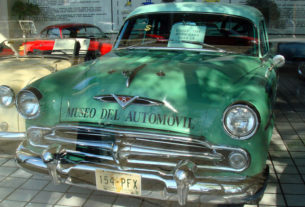Mexican music has its roots in the Indian flute, huehuetl (drum) and conch shell. The Spaniards brought their musicians with them as the Indian music proved inadequate for bullfights.
Bullfighting and bullfight music originates in Pharanoic Egypt and was introduced into Spain by the Moors. Mexico’s first bullfight took place in Mexico City in 1526 (to honor Cortes upon his return from a Honduran expedition) and the first bullfight music was heard in the new world.
French music impinged itself on the Mexican scene during the French intervention (when Emperor Maximilian and Empress Carlota reigned supreme) from 1862-1867…and the Mexican mariachi was born.
All mariachi say that Jalisco was the birthplace from whence the name is derived. The word itself seems to be a variation of the French word mariage for which music was provided…mostly waltzes, polkas, and the instruments were the harp, violin, and guitar.
The French mariage (marriage) evolved into “mariachi”, as this type of mexican musician is commonly known to this day, and they play all kinds of music. The most popular combination of instruments is two violins, a harp, guitarrón (bass guitar), and guitarra de golpe, a five-string instrument that is tuned differently from the others.
Musicians say that it is not easy to be a mariachi. Only those who have the proper heritage find it a good life…not everyone can do it – MARIACHI MUSIC MUST COME FROM THE HEART.
ANOTHER EXPRESSION OF THE HEART – THE CORRIDO
The young women was called Adelita. She was brave and beautiful and in love with The Sergeant. And so she followed him wherever he and his unit were encamped. And what did everyone hear the Sergeant singing? What did he say?
“If Adelita were to leave with another man, I would follow her over land and sea…over the sea by warship, over land in a military train. And if I die in battle, and they are going to bury my cadaver, Adelita, in God’s name, I pray that you will cry for me.”
It sounds better in Spanish with the shouting and bugles. Dance to it, drink with it, cry to it, or fight. The tune is “La Adelita”. The time is the Mexican Revolution that devastated Mexico for several years beginning in 1910, and whether the original Adelita existed or not, the name signified any woman who followed her man to war, whether she rode on the train with him, rifle blazing, or on her horse, pistola at her hip. Mariachis who emerged from the revolution adopted “Adelita” as one of their favorite tunes and it became a folk song over the years.
Adelita was not the only brave and beautiful women to follow her man to war…there was “La Valentine” and “Marieta”, too.
Pancho Villa’s favorite horse had a tune named from him… “El Siete Leguas” (The Seven Leagues). And another tune as well… “La Cucaracha” (The Cockroach). It was well known in the United States and it was the name of Pancho Villa’s big black automobile. “Maquina 501” (Engine 501) tells a sad tale of a man’s bravery and sacrifice of his life to save a town from a runaway train. All of these songs became known as corridos, a name derived from occurido (an occurrenceor happening).
Like the minstrel of Europe, the Mexican juglar (minstrel) used to go from town to town repeating news and gossip. “øQué ha ocurrido?” (What has happened?) And his musical replies, now folk ballads, also came to be known as corridos.
New songs are being written regularly and now they tell different “ocurridos” of current Mexican life. One recent corrido is “Carga Blanca” ( blanca, white, in this case means heroin). Another is “El Tahur” (a gambler skilled at cards). “Contrabando en Nogales” is obvious, and “El Asesino” (The Assassin) tells of a jealous man who kills his woman because of a triangle and he is being chased by police as he searches for the third party.
Another corrido is about Joaquin Murrieta, native of Sonora who live in the Gold Rush era in California and became known as a cutthroat bandido. One more recent one is about Fernando Valenzuela, former Los Angeles Dodger’s pitching star. It is called “Tirabuzón”. Tirabuzón is a word for corkscrew, which is sort of what Fernando’s Sunday pitch, his screwball, looks like to National Baseball League batters as it twists and dips.
Sometimes these “occurrences” are very unhappy ones: the corrido is written in remembrance, or in protest of what the people consider grave government errors. Some heart-wrenching themes are the Student Uprising of 1968, the 1985 Earthquake, etc. These songs may not make the Top Ten list, but are a definite part of Mexican heritage.
This article originally appeared in “Mexico Living and Travel Update”, Fall 1994, and is presented here with their kind permission.

